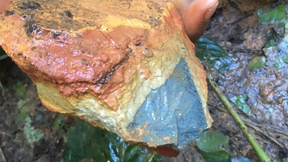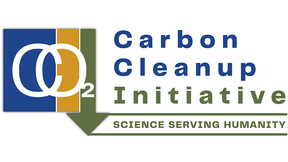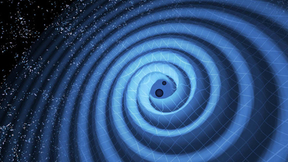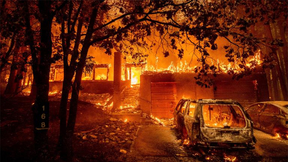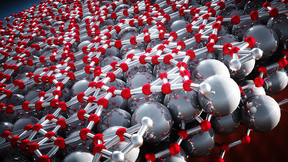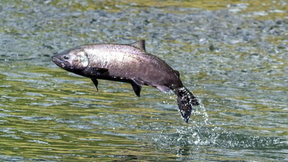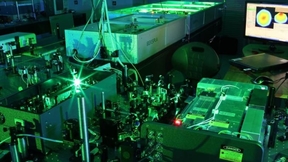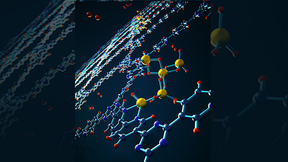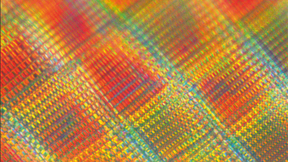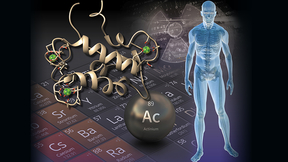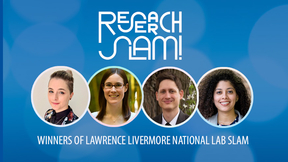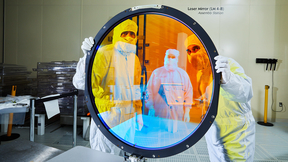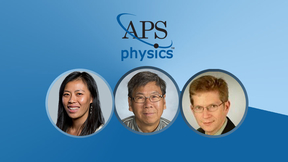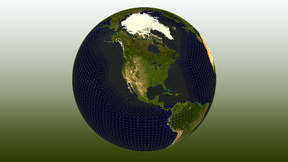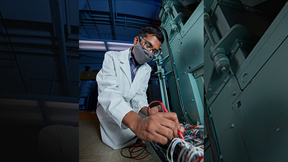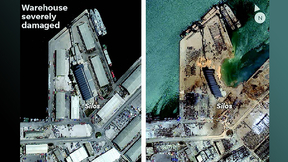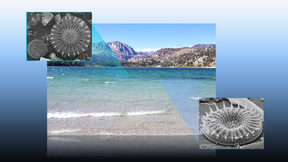Back
Physical and Life Sciences
Soil carbon storage rocks on
Rock weathering controls the potential for soil carbon storage at a continental scale. New research from Lawrence Livermore National Laboratory (LLNL) and collaborators found that rock weathering — the process of chemical transformation by long exposure to water and the atmosphere — boosts soil organic carbon storage by altering soil mineralogy. The research appears in the…
Livermore Lab Foundation, Lawrence Livermore National Lab launch carbon education and outreach program
Helping the general public and students learn about carbon neutrality, the options for carbon dioxide removal, as well as the effects of climate change, is the focus of the Carbon Cleanup Initiative, a unique public awareness partnership from the Livermore Lab Foundation (LLF) and Lawrence Livermore National Laboratory (LLNL). “We are proud to partner with the scientists…
LLNL-led team uses machine learning to derive black hole motion from gravitational waves
The announcement that the Laser Interferometer Gravitational-wave Observatory (LIGO) had detected gravitational waves during the merger of two black holes sent ripples throughout the scientific community in 2016. The earthshaking news not only confirmed one of Albert Einstein’s key predictions in his general theory of relativity, but also opened a door to a better…
Human-caused climate change increases wildfire activity
The western United States has experienced a rapid increase of fire weather as the vapor pressure deficit (VPD) increases in the area during the warm season. New research by scientists at University of California, Los Angeles (UCLA) and Lawrence Livermore National Laboratory (LLNL) shows that two-thirds (approximately 68 percent) of the increase in VPD is due to human…
Disorder in surface materials key to better hydrogen storage
Lawrence Livermore National Laboratory (LLNL) scientists have found that atomic disorder in certain boron-based hydrogen storage systems can potentially improve the rate of hydrogen uptake. Metal boride surfaces and their single-layer variants — known as borophenes — are generally thought to feature a regular arrangement of atoms at low to moderate temperatures. The LLNL…
Survivor salmon persist through drought and ocean warming
In drought years and when marine heat waves warm the Pacific Ocean, the rare late-migrating juvenile spring-run Chinook salmon of California’s Central Valley are the survivors. They are among the few salmon that return to spawning rivers in those difficult years to keep their populations alive, according to results published today in Nature Climate Change. The trouble is…
Polymer Production Enclave Puts Additive Manufacturing on the Fast Track
Since its establishment, Lawrence Livermore has played a critical role in designing components for the Nuclear Security Enterprise (NSE), and more recently, in developing additively manufactured polymer parts to replace aging weapons stockpile parts.
LLNL researchers garner three awards among top 100 industrial inventions
Lawrence Livermore National Laboratory (LLNL) scientists and engineers have collected three awards among the top 100 industrial inventions worldwide. The trade journal R&D World Magazine announced the winners of the awards, often called the “Oscars of invention,” during a three-day virtual ceremony — Oct. 19-21 — and on the magazine’s website. With this year’s results,…
New hydrogen storage material steps on the gas
Hydrogen is increasingly viewed as essential to a sustainable world energy economy because it can store surplus renewable power, decarbonize transportation and serve as a zero-emission energy carrier. However, conventional high-pressure or cryogenic storage pose significant technical and engineering challenges. To overcome these challenges, Lawrence Livermore National…
Tube-in-tube structure going strong
Similar to grass stems, Lawrence Livermore National Laboratory (LLNL) scientists have created nanostrut-connected tube-in-tubes that enable stronger low-density structural materials. Porous materials with engineered stretching-dominated lattice designs, which offer attractive mechanical properties with ultra-light weight and large surface area for wide-ranging applications…
PLS postdocs battle it out at the 2021 Research Slam!
Lawrence Livermore National Laboratory’s (LLNL’s) fifth annual Research Slam! took place virtually on October 6th and featured 14 LLNL postdocs, 9 of which represented the Physical and Life Sciences Directorate (PLS). Over 300 people logged on to attend the live two-hour event, enthusiastically cheering for their favorite postdocs in the comment section. Each finalist was…
Cancer therapies and nuclear material detection get a boost from newly discovered protein
Lawrence Livermore National Laboratory (LLNL) and Penn State scientists have demonstrated how a protein can be recovered and purified for radioactive metals like actinium that could be beneficial for both next-generation drugs used in cancer therapies and the detection of nuclear activities. Radioactive metals hold unique and essential places in a variety of medical…
Lawrence Livermore Research Slam! winners advance to Bay Area competition
The top winners of the recent Lawrence Livermore National Laboratory (LLNL) Research Slam!, a speaking competition for postdocs, will advance to the Bay Area Research SLAM set for Thursday, Oct. 28. The Bay Area Research SLAM! is a collaboration between the Bay Area’s national labs (Lawrence Berkeley National Laboratory, LLNL, Sandia National Laboratories and SLAC National…
LLNL engineers deliver final optical components for world’s newest telescope: the Vera C. Rubin Observatory
For much of the past decade, Lawrence Livermore National Laboratory (LLNL) researchers have been designing major optical components for the world’s newest telescope, while their industrial partners have fabricated the components. Now, with the September shipment of the last of six optical filters for the telescope’s camera to the SLAC National Accelerator Laboratory in…
Three LLNL scientists honored as APS fellows
Three Lawrence Livermore National Laboratory (LLNL) physicists have been selected as 2021 fellows of the American Physical Society (APS). The new fellows represent a selection of physics expertise, ranging from intense laser-matter interactions and inertial fusion energy science to leading the development of edge simulation models and codes to pioneering new regimes of…
Updated exascale system for earth simulations
A new version of the Energy Exascale Earth System Model (E3SM) is two times faster than its earlier version released in 2018. Earth system models have weather-scale resolution and use advanced computers to simulate aspects of Earth’s variability and anticipate decadal changes that will critically impact the U.S. energy sector in coming years. Version 2 of the Energy…
Making it count: Rebuilding infrastructure at the Nuclear Counting Facility
When Daniel Martin put the finishing touches on an autonomous vehicle robot, complete with an ultrasonic sensor to detect and evade obstacles, he knew he wanted to become an engineer. A high school student at the time, he was fascinated by the design and functionality of robots. Fast forward several years, and Martin is now a second-year electrical engineering Ph.D…
Just how big was the 2020 Beirut explosion?
On Aug. 4, 2020, one of the largest non-nuclear explosions in history pulverized a Beirut port and damaged more than half the city. The explosion resulted from the detonation of tons of ammonium nitrate, a combustible chemical compound commonly used in agriculture as a high-nitrate fertilizer, but which can also be used to manufacture explosives. Since that time, the…
Climate change in the Sierra Nevada has profoundly altered its lake ecosystems
Climate change has significantly impacted the natural systems of the Sierra Nevada, including the mountain lakes that are an iconic part of California’s natural beauty. New research from a Lawrence Livermore National Laboratory (LLNL) scientist and colleagues from the University of Kentucky (UK) and Indiana State University (ISU) shows that lake-sediment cores from a…
Late-time small-body disruptions can protect the Earth
If an asteroid is determined to be on an Earth-impacting trajectory, scientists typically want to stage a deflection, where the asteroid is gently nudged by a relatively small change in velocity, while keeping the bulk of the asteroid together. A kinetic impactor or a standoff nuclear explosion can achieve a deflection. However, if the warning time is too short to stage a…


